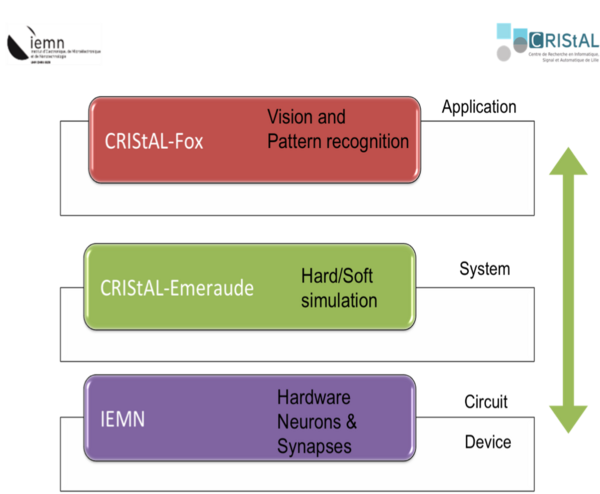Bio-inspired architectures
The human brain has the ability to perform complex tasks with an energy efficiency far superior to that of the most powerful computers. We took inspiration from the brain to propose neuro-inspired information processing architectures with ultra-low power consumption.
The originality of the IRCICA bio-inspired architecture project is threefold:
• The technology used, the sub-threshold CMOS process, is extremely energy efficient and is able to generate electrical impulses (or spikes) similar in amplitude and time constant to those encountered in biological neural networks.
• The hardware architecture in the form of networks of component networks distributes calculation and storage, which we can be simulated for optimum energy efficiency and speed.
• Natural computation and learning can be simulated and implemented on this type of architecture especially in the field of vision.
The work done in the recent years has identified a number of difficulties to overcome such as: the choice of the pre-processing and input data encoding, the adequacy of learning rules and network architectures to the targeted tasks as well as the up-scaling up (number of layers, quantity and complexity of data).
Future work will be concentrated on three directions: simulation and visualization, unsupervised learning of images and videos, and 3D circuits whose architecture will also be bioinspired.

IRCICA Projects (mostly in french)
ALGORITHMES ET DONNEES AUDIO/VIDEO A IMPULSIONS
Le cerveau des mammifères a la capacité d'effectuer des tâches complexes avec une efficacité informatique et énergétique inégalée. On pense que l'un des principaux facteurs de cette efficacité est le fait que les informations sont codées via nos 5 sens sous la forme de trains d‘impulsions analogiques biologiques, donc non discrets. Nous nous inspirons du cerveau pour proposer des capteurs et des architectures de traitement de l'information dite neuroinspirés sans horloge centrale et avec une consommation électrique ultra-faible. L'originalité du projet d'architecture bio-inspirée à l’ IRCICA est quadruple :
- Une technologie reposant sur CMOS sous-seuil qui a conduit au développement d'un neurone artificiel ultrabasse puissance (ULP) (l'unité neuronale de base), qui produit des impulsions électriques d'amplitude similaire (~ 100 mV) et constante de temps à celles rencontrées dans les réseaux de neurones biologiques.
- Le développement des capteurs acoustiques et visuels bio inspirés basés sur cette technologie ultra basse consommation
- L'architecture matérielle sous la forme de réseaux de neurones à impulsions qui distribuent le calcul et le stockage, et peuvent être ajustés pour optimiser à la fois l'efficacité énergétique et la vitesse.
- Calcul naturel et apprentissage simulables et implémentables sur ce type d'architecture notamment dans le domaine de la vision 3D et de l'acoustique binaurale.
Caméras bio-inspirées et carte FPGA pour la plateforme technologique neuromorphique
Dans le cadre de la nouvelle plateforme technologique neuromorphique de l’IRCICA et les différents projets qui se lancent cette année tel que la chaire industrielle ANVI (Architectures Neuromorphiques pour la Vidéoprotection : chaire-luxant-anvi.univ-lille.fr) et l’ANR ULP COCHLEA avec nos partenaires électroniciens de l’axe bio-inspiré, on présente cette demande d’achat de caméras bio-inspirées et de carte FPGA pour mieux munir nos recherches et qui seront complémentaires a la carte Spinnaker disponible déjà a l’IRCICA.
Conception d’une cochlée artificielle bioinspirée ultra faible consommation pour monitorer la biodiversité sous-marine
Ce projet s’inscrit au niveau régional et national autour du développement de systèmes embarqués, pour lesquels le développement de capteurs bioinspirés écodurables, intégrant de l’IA, est impératif. L’application principale sera l’utilisation de ces capteurs pour monitorer la biodiversité marine (reconnaissance / classification / comptage de grand cétacés), mais la généricité du capteur qui sera développé pourrait à l’avenir être adapté à la faune terrestre (par exemple, outil d’aide à la préservation d’espèces d’oiseaux menacés) .
Architectures matérielles bioinspirées pour le traitement de l’information
Les circuits de type FPGA constituent une cible prometteuse pour l’implémentation des réseaux de neurones impulsionnels en raison de leurs flexibilité et configurabilité importantes. L’objectif de ce stage est d’étudier la faisabilité de la construction de réseau de neurones basés sur le modèle d’Izhikevich sur FPGA, d’en mesurer la complexité en espace et les capacités d’interfaçage avec des dispositifs communicant avec le format AER.
Apprentissage supervisée basse consommation pour la vision par ordinateur
Le premier objectif du projet est de réaliser un démonstrateur réalisant la localisation d’objets via un système de vision bio-inspiré couplé à un bras robotique qui embarque une carte programmable. Le deuxième objectif est d’évaluer les performances des modèles d'apprentissage supervisés dans un contexte SNN sur des tâches de classification de vidéos.
To be filled soon
To be filled soon
To be filled soon
To be filled soon
